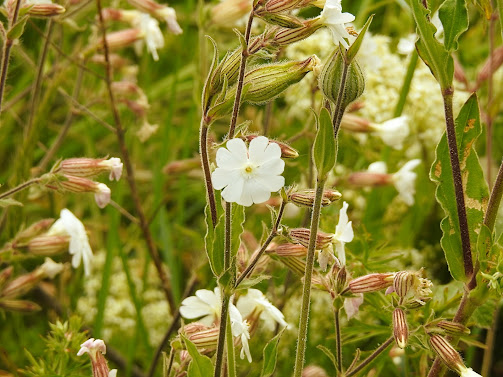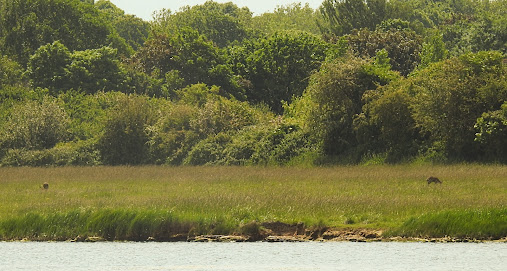Friday 2nd June 2023.
I went over to the ‘dark side’ this morning and took a walk along the west side of Thorney Island for the first time this year. Yes, I have been birding only in Hampshire all year, but seeing that this area of Thorney Island is a good bet to see a Lesser Whitethroat (not seen or heard one yet this year), I thought what the hell, let's give it a go. Of course, there was no sight or sound of one, but it was most certainly a cracking trip to this side of West Sussex with a variety of birds and nature to look at during the couple of hours I was there.
The trip here started nicely with a singing Common Whitethroat perched on a bush by the main track leading to the seawall on the west side of Thorney Island, while nearby, I could hear both Reed Bunting and Reed Warbler singing in the large reedbed to the south of the footpath. Sadly, as always here, there was dog poop all over the place along the path due to irresponsible dog owners, so I had to watch my step. I rarely walk fast along this path as there is so much to look at and not just birds. In fact, there weren't that many birds along the path, but plenty of plants and insects to look at.
There were plenty of buttercups around including the bright yellow Bulbous Buttercup , Hemlock Water-dropwort and Mallow growing along the path and great swathes of Yorkshire Fog grass grew along the edge of the path. Dog Rose bushes were also in bloom and looking quite stunning in the sunshine that attracted Buff-tailed Bumble Bees to their flowers. I stopped briefly to watch a female Marsh Harrier hunting over the reedbeds south of the footpath, lazily twisting and turning and then gliding gracefully over the Little Deeps area until disappearing from view. A few Swallows headed north and several Swifts were seen hawking in the blue sky above.
I had a quick look at the harbour where the tide was almost at its highest, but little of note when it came to the birdlife, so I promptly made my way down to the main footpath leading south to the Great Deeps. Another Common Whitethroat was seen singing as I made my way down the footpath leading to the Little Deeps. The bench on the harbour wall was very inviting and from here, I could see at least three species of raptor that included two Marsh Harriers, one Common Buzzard and a hovering Kestrel in the same field of view to the east of the island. Another small group of three Swifts flew over all heading north, though on the Little Deeps, there was very little bar, one Little Grebe and a sleeping drake Tufted Duck. A singing Reed Warbler popped up on top of the reeds and showed well, but a singing Cetti’s Warbler remained typically hidden. A nice surprise was a Common Sandpiper that took off from the Little Deeps then flew over into the harbour and then headed off south low over the water.
I admired the many flowering plants along the footpath down to the Great Deeps that included Smooth Tare, Hoary Cress, Hop Trefoil and Common Cats Ear that was growing along the harbour wall and along the edge of the footpath, which in turn attracted a good number of Thick-legged Flower Beetles that took full advantage of the flowering plants. Despite a good lengthy walk, I only saw just one butterfly, which I think was a Common Blue, but took off before I could get a good look at it. Out in the Gorse fields, both Linnets and Goldfinches were abundant and both Skylark and Meadow Pipits were seen singing over the fields.
On reaching the Great Deeps, I checked out the bird life present that included at least 8 Common Terns flying low over the water. Some flew out over my head and into the harbour while the others flew east towards the new Tern Rafts present. I didn't have my scope with me and so I was not sure what was nesting on the rafts, but with this many Common Terns here, I assume they are nesting on them? On the nearby stretch of shoreline mud, singles of Oystercatcher and Ringed Plover were found and on the south side of the Great Deeps, both Little Egret and Grey Heron were stalking the shallow water close to one another. A few Shelduck swam on the water and out on the fields south of the Great Deeps, two Roe Deer were grazing.
The walk back was pleasant enough, but now I was facing a breezy northerly wind, though it was nice once the sun reappeared from behind the few large clouds. On reaching the Little Deeps again, a Sedge Warbler was now in full song and showed well enough for me to grab a few nice photos. The footpath leading back towards my car held a singing Chiffchaff perched high on an overhead wire, while a family of Common Whitethroats were skulking about in the hedgerows near me including a couple of youngsters quivering their wings to be fed and a male Reed Bunting was observed flying over the nearby reedbeds and then land in a tree at the end of the path. Nearing the end of the footpath, a large Dragonfly landed on the ground and though a bit distant, I was sensible enough to grab a few photos of which I have now identified as a male Black-tailed Skimmer Dragonfly.
I got the heads up from fellow ‘Lazee’ Mark Francis that there were up to 6 Black Terns now feeding among the Gull flock within the Solent; seen from the Brownwich area of Gosport. I am tempted to go to view them later today, but we shall see as I am absolutely knackered. It's not easy getting up at 4.45am; but ‘no pain then no gain’ as they say!


























No comments:
Post a Comment